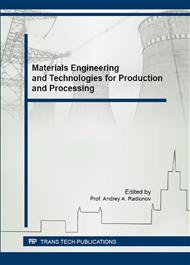[1]
Y. Pauleau, Materials Surface Processing by Directed Energy Techniques, Elsevier, (2006).
Google Scholar
[2]
V.A. Shulov, A.S. Novikov, A.G. Paikin, A.I. Ryabchikov, Erosion resistance of refractory alloys modified by ion beams Original Research Article, Surface and Coatings Technology. 201 19-20 (2007) 8105-8111.
DOI: 10.1016/j.surfcoat.2006.01.092
Google Scholar
[3]
D.J. Rej, H.A. Davis, M. Nastasi, J.C. Olson, E.J. Peterson, R.D. Reiswig, K.C. Walter, R.W. Stinnett, G.E. Remnev, V.K. Struts, Surface modification of AISI-4620 steel with intense pulsed ion beams, Original Research Article Nuclear Instruments and Methods in Physics Research Section B: Beam Interactions with Materials and Atoms. 127-128 (1997).
DOI: 10.1016/s0168-583x(97)00044-x
Google Scholar
[4]
V.M. Anishchik, V.V. Uglov, V.V. Astashynski, V.M. Astashynski, S.I. Ananin, E.A. Kostyukevich, A.M. Kuzmitski, N.T. Kvasov, A.L. Danilyuk, I.N. Rumianceva, Compressive plasma flows interaction with steel surface: structure and mechanical properties of modified layer, Original Research Article, Vacuum. 70 2-3 (2003).
DOI: 10.1016/s0042-207x(02)00654-1
Google Scholar
[5]
A.J. Kinloch, Adhesion and Adhesives: Science and Technology, Springer Science & Business Media, (1987).
Google Scholar
[6]
Soo Hong Kim, Sun Woong Na, N. -E. Lee, Yun Woo Nam, Young-Ho Kim, Effect of surface roughness on the adhesion properties of Cu/Cr films on polyimide substrate treated by inductively coupled oxygen plasma, Surface & Coatings Technology. 200 (2005).
DOI: 10.1016/j.surfcoat.2005.05.021
Google Scholar
[7]
Ju Dy Lim, Pui Mun Lee, Daniel Min Woo Rhee, Kam Chew Leong, Zhong Chen, Effect of surface treatment on adhesion strength between magnetronsputtered copper thin films and alumina substrate, Applied Surface Science. 355 (2015) 509-515.
DOI: 10.1016/j.apsusc.2015.07.141
Google Scholar
[8]
J.A. Juárez-Moreno, A. Ávila-Ortega, A.I. Oliva, F. Avilés, J.V. Cauich-Rodríguez, Effect of wettability and surface roughness on the adhesion properties of collagen on PDMS films treated by capacitively coupled oxygen plasma, Original Research Article Applied Surface Science. 349 (2015).
DOI: 10.1016/j.apsusc.2015.05.063
Google Scholar
[9]
Z. Ghalmi, M. Farzaneh, Experimental investigation to evaluate the effect of PTFE nanostructured roughness on ice adhesion strength, Original Research Article Cold Regions Science and Technology. 115 (2015) 42-47.
DOI: 10.1016/j.coldregions.2015.03.009
Google Scholar
[10]
V.M. Astashynski, A.Y. Leyvi, K.A. Talala, V.V. Uglov, N.N. Cherenda, A.P. Yalovets, Change in the relief of a target surface treated by compression plasma flows, Journal of Surface Investigation. 7 (5) (2013) 1005-1012.
DOI: 10.1134/s102745101305025x
Google Scholar
[11]
V.M. Astashynski, A.Y. Leyvi, V.V. Uglov, N.N. Cherenda, A.P. Yalovets, Formation of Relief on a Metallic Target Surface under the Action of Compression Plasma Flows, Journal of Surface Investigation. 8 (3) (2014) 519-523.
DOI: 10.1134/s1027451014030239
Google Scholar
[12]
V.M. Astashynski.
Google Scholar
[13]
V.S. Krasnikov, A. Ya. Leyvi, A.E. Mayer, A.P. Yalovets, Surface microrelief smoothing mechanisms in a target irradiated by an intense charged particle beam, Technical Physics. 52 (4) (2007) 431-439.
DOI: 10.1134/s1063784207040068
Google Scholar
[14]
P. Raharjo, K. Uemura, A. Okada, Y. Uno, Proc. of the 7th Int. Conf. on Modification of Materials with Particle Beams and Plasma Flows. (2004) 263.
Google Scholar
[15]
P. Raharjo, K. Uemura, A. Okada, Y. Uno, Proc. of the 7th Int. Conf. on Modification of Materials with Particle Beams and Plasma Flows. (2004) 267.
Google Scholar
[16]
V.A. Shulov, A.S. Novikov, A.G. Paikin, A.B. Belov, A.F. Lvov, G.E. Remnev, Crater formation on the surface of refractory alloys during high-power ion-beam processing, Original Research Article Surface and Coatings Technology. 201 19-20 (2007).
DOI: 10.1016/j.surfcoat.2006.01.078
Google Scholar
[17]
A.I. Morozov, Nuclear Fusion, Special Suppl., (1969).
Google Scholar
[18]
N.P. Kozlov, Yu.S. Protasov, On the mechanism of a plasma focus formation in an ablation type magnetoplasma compressor, Physics letters. 67A 3 (1978).
DOI: 10.1016/0375-9601(78)90487-5
Google Scholar
[19]
V.M. Anishchik, V.V. Uglov, V.V. Astashynski, I.N. Rumianceva, Compressive plasma flows interaction with steel surface: structure and mechanical properties of modified layer.
DOI: 10.1016/s0042-207x(02)00654-1
Google Scholar
[20]
A. Ya. Leyvi, A.E. Mayer, V.A. Shulov, A.P. Yalovets, The influence of initial target surface state and irradiation parameters on the micro-craters formation, Proceedings of the Int. Conf. on Modification of Materials with Particle Beams and Plasma Flows. (2008).
Google Scholar


